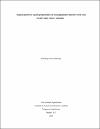Espacio genérico y espacio programático en un equipamiento educativo rural en la vereda Campo Alegre, Antioquia
Resumen
Este trabajo contiene la investigación arquitectónica que se llevó a cabo en el municipio Carmen de Viboral, específicamente en la vereda Campo Alegre, Antioquia que tuvo como tema central la relación entre el espacio genérico y espacio programático para la realización de una escuela rural enfocada hacia un modelo pedagógico diferente al tradicional partiendo de una modificación del espacio que contengan una transformación y una flexibilidad en su área. La problemática del espacio delimitado y mono funcional que se ve tradicionalmente en los equipamientos educativos es debido a que no se planifica la distribución de estos espacios lo que se evidencian en la repetición de los mismos, y en que no cuentan con cambio en su uso ya que este es determinado. De tal modo se ignora el modelo de aprendizaje que debe ser ente identificador en cada equipamiento educativo. Para responder esta problemática del espacio, se plantea un programa para un modelo de aprendizaje que se compone de un ámbito educativo comunitario y productivo que permite crear un nuevo método de aprendizaje adaptable a espacios flexibles y multifuncionales, pues partimos de la idea de que el espacio es modificable y es complemento con el límite permitiendo que este se extienda sobre su área. Esto, debido a que la organización del espacio programático se combina y se intercala con el espacio genérico que permite contar con nuevas áreas para el desarrollo de actividades con modificación y nuevas distribuciones del espacio.
Abstract
This work contains the architectural research that was carried out in the municipality Carmen de Viboral, specifically in the sidewalk Campo Alegre, Antioquia that had as its central theme the relationship between generic space and programmatic space for the realization of a rural school focused on a pedagogical model different from the traditional starting from a modification of the space containing a transformation and a flexibility in your área. The problem of the limited and mono-functional space traditionally seen in educational facilities is due to the fact that the distribution of these spaces is not planned, which is evident in the repetition of them, and that they have no change in their use since this is determined. This ignores the learning model that should be the identifier in each educational equipment. To answer this problem of space, a programme is proposed for a learning model that is composed of a community and productive educational environment that allows creating a new learning method adaptable to flexible and multifunctional spaces, as we start from the idea that the space is modifiable and is complement with the limit allowing it to extend over its area. This is because the organization of the programmatic space is combined and interspersed with the generic space that allows for new areas for the development of activities with modification and new distributions of space.
Collections
 This work is licensed under a Creative Commons Reconocimiento-NoComercial 4.0.
This work is licensed under a Creative Commons Reconocimiento-NoComercial 4.0.

